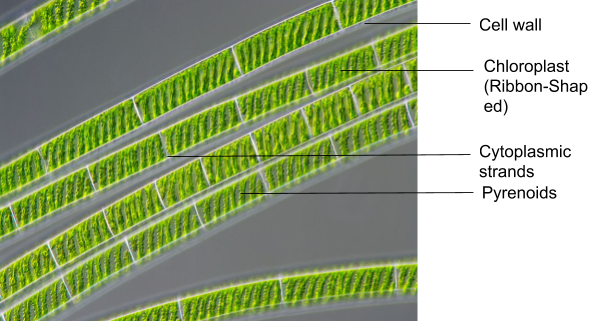
Draw a neat diagram of spirogyra and label on it- Jelly like substance in the cell where the organelles are suspended.
Answer
538.2k+ views
Hint: Spirogyra any genus member of some 400 free-floating green algae species of the Chlorophyta division found globally in freshwater environments Spirogyras are filamentous algae consisting of thin unbranched chains of cylindrical cells, named for their exquisite spiral chloroplasts.
Complete answer:
They can form masses that float near the surface of streams and ponds, buoyed by oxygen bubbles produced during photosynthesis.. They are widely used in laboratory demonstrations. Each filament cell has a large central vacuole, within which fine cytoplasm strands suspend the nucleus.
The chloroplasts form a spiral around the vacuole and have specialised bodies that store starch, known as pyrenoids.. The cell wall is formed by the inner layer of cellulose and the outer layer of pectin, which is responsible for the slippery texture of the algae.
Species of Spirogyra can reproduce sexually as well as asexually. Asexual, or vegetative, reproduction occurs by simple filament fragmentation. Sexual reproduction occurs by a mechanism known as conjugation, in which outgrowths called conjugation tubes are joined by cells of two filaments lying side by side.
This helps one cell's contents to fully move into and fuse with the other's contents. A dense wall covers and overwinters the resulting fused cell (zygote), while the vegetative filaments die.

Note: An unbranched filamentous thallus is the vegetative structure of Spirogyra.
With - cylindrical cells joining end to end, the thallus is multicellular.
They are 10-100 μm wide and can be several centimetres tall.
Owing to the presence of the mucilage sheath around the filament, they are present as a slimy mass
Complete answer:
They can form masses that float near the surface of streams and ponds, buoyed by oxygen bubbles produced during photosynthesis.. They are widely used in laboratory demonstrations. Each filament cell has a large central vacuole, within which fine cytoplasm strands suspend the nucleus.
The chloroplasts form a spiral around the vacuole and have specialised bodies that store starch, known as pyrenoids.. The cell wall is formed by the inner layer of cellulose and the outer layer of pectin, which is responsible for the slippery texture of the algae.
Species of Spirogyra can reproduce sexually as well as asexually. Asexual, or vegetative, reproduction occurs by simple filament fragmentation. Sexual reproduction occurs by a mechanism known as conjugation, in which outgrowths called conjugation tubes are joined by cells of two filaments lying side by side.
This helps one cell's contents to fully move into and fuse with the other's contents. A dense wall covers and overwinters the resulting fused cell (zygote), while the vegetative filaments die.

Note: An unbranched filamentous thallus is the vegetative structure of Spirogyra.
With - cylindrical cells joining end to end, the thallus is multicellular.
They are 10-100 μm wide and can be several centimetres tall.
Owing to the presence of the mucilage sheath around the filament, they are present as a slimy mass
Recently Updated Pages
Master Class 12 Business Studies: Engaging Questions & Answers for Success

Master Class 12 Economics: Engaging Questions & Answers for Success

Master Class 12 English: Engaging Questions & Answers for Success

Master Class 12 Maths: Engaging Questions & Answers for Success

Master Class 12 Social Science: Engaging Questions & Answers for Success

Master Class 12 Chemistry: Engaging Questions & Answers for Success

Trending doubts
What is meant by exothermic and endothermic reactions class 11 chemistry CBSE

Which animal has three hearts class 11 biology CBSE

10 examples of friction in our daily life

One Metric ton is equal to kg A 10000 B 1000 C 100 class 11 physics CBSE

1 Quintal is equal to a 110 kg b 10 kg c 100kg d 1000 class 11 physics CBSE

Difference Between Prokaryotic Cells and Eukaryotic Cells




